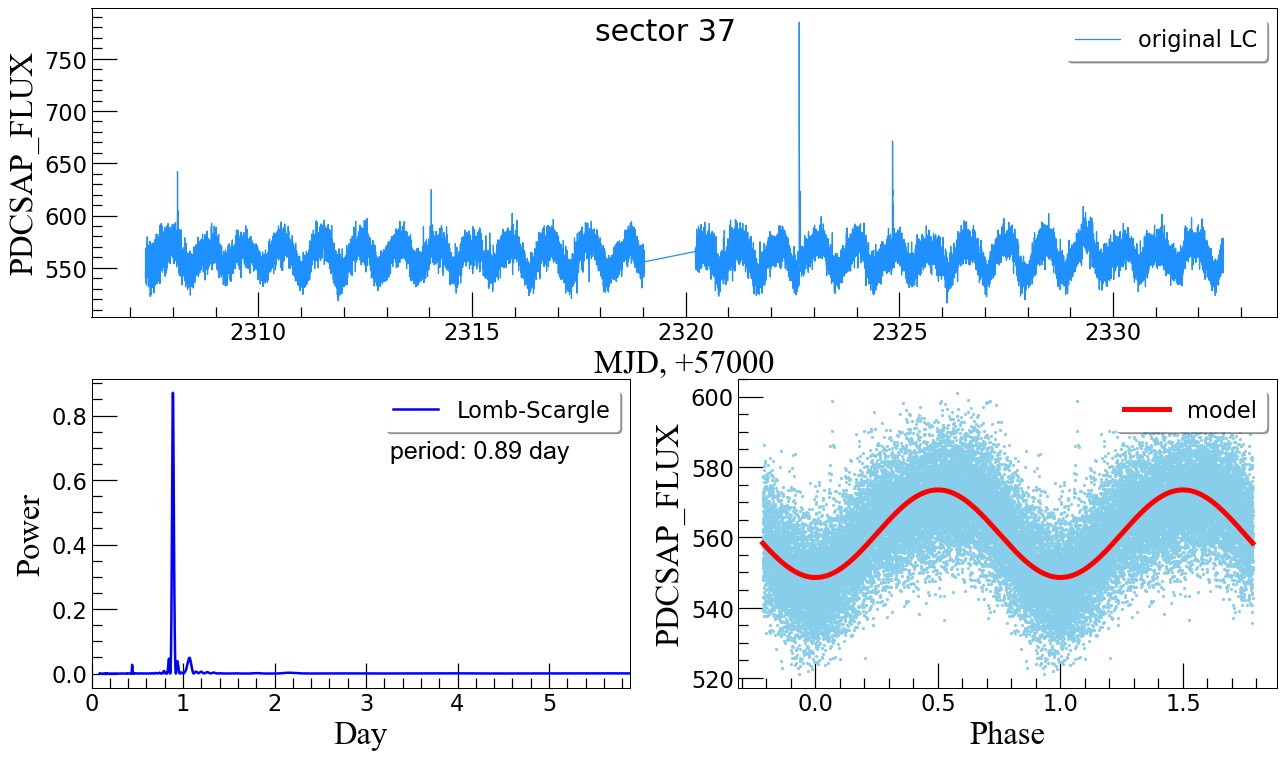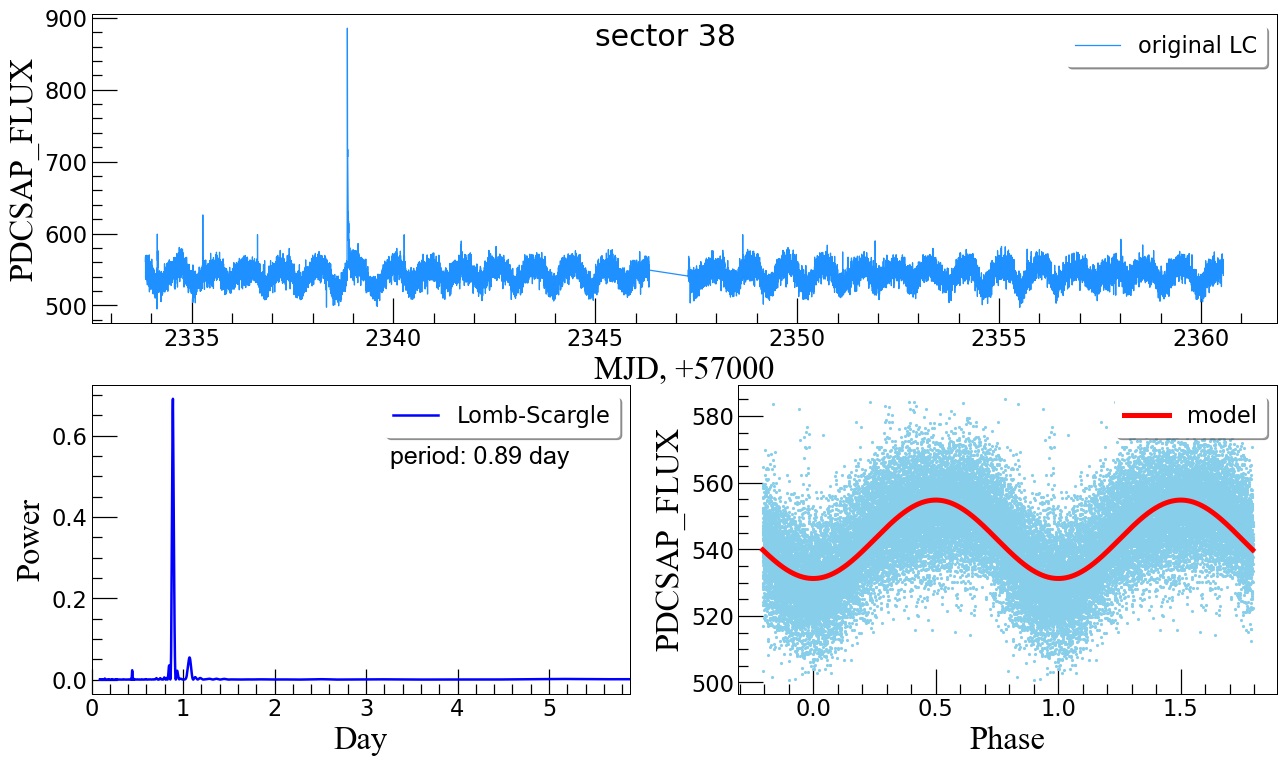|
Peremennye Zvezdy (Variable Stars) 44, No. 10, 2024 Received 15 November; accepted 24 November. |
Article in PDF |
|
DOI: 10.24412/2221-0474-2024-44-128-130
|
The First Determination of the Rotation Period for DH Car
Mark A. Gorbachev
Crimean Astrophysical Observatory, Nauchny 298409, Crimea, Russia
| In January 1924, Ejnar Hertzsprung discovered a new variable star, DH Car. As it later turned out, this was the first discovery of a flaring red dwarf, type UV Cet in current classification. I present the first determination of the rotation period of DH Car from data acquired with TESS orbital observatory. The period is 0.89 days. |
1. Introduction
Ejnar Hertsprung (1924) gave his paper on the discovery of the
variable star, later designated DH Car in the standard
variable-star manner, the name "Note on a peculiar variable star
or Nova of short duration". In the beginning of the paper, he
writes: "On the night of 1924 January 29 I took 5 plates in
succession each with 30 minutes, followed by 4 plates each with
![]() minutes exposure time...". The plates showed a
brief brightening of the star by
minutes exposure time...". The plates showed a
brief brightening of the star by
![]() (pg). Historically, it
was the first observation of a flare on a star of the faint part
of the main sequence; such stars are now called UV Ceti variables
(cf. Samus et al. 2017). Hertzsprung (1924) suggested an
interesting, now completely obsolete, explanation of the event:
"A rough estimate indicates that a fall into the star of a body
like a small planet would yield sufficient energy for an outburst
as observed, but there may of course be other causes for the
phenomenon".
(pg). Historically, it
was the first observation of a flare on a star of the faint part
of the main sequence; such stars are now called UV Ceti variables
(cf. Samus et al. 2017). Hertzsprung (1924) suggested an
interesting, now completely obsolete, explanation of the event:
"A rough estimate indicates that a fall into the star of a body
like a small planet would yield sufficient energy for an outburst
as observed, but there may of course be other causes for the
phenomenon".
Regardless the importance of the star DH Car, the literature on it is very limited. As of November 2024, the Simbad database lists only 11 publications, most of which not directly related to the object itself. Remarkably there is no reference to Hertzsprung (1924) in the list.
The coordinates of DH Car are: RA = 11![]() 14
14![]() 51
51![]() 752, Dec =
-61
752, Dec =
-61![]() 45
45![]() 37
37
![]() 11 (equinox and epoch 2000.0). The star has
a companion in 4
11 (equinox and epoch 2000.0). The star has
a companion in 4
![]() 5 to the east. Using the
5 to the east. Using the ![]() ,
, ![]() , and
, and
![]() magnitudes from the Gaia DR3 catalogue (Gaia Collaboration et
al. 2023) and interpolating in the table provided by
E. Mamajek1(cf. Pecaut et al. 2012), we find the star's visual magnitude
magnitudes from the Gaia DR3 catalogue (Gaia Collaboration et
al. 2023) and interpolating in the table provided by
E. Mamajek1(cf. Pecaut et al. 2012), we find the star's visual magnitude ![]() and spectral type M4V. The Gaia DR3 catalogue gives
and spectral type M4V. The Gaia DR3 catalogue gives
![]() K,
K, ![]() cm s
cm s![]() , [Fe/H] = -0.47,
distance 84 pc.
, [Fe/H] = -0.47,
distance 84 pc.
Today, 100 years after its discovery, we revisit the star DH Car, based on data from the TESS2 (Transiting Exoplanet Survey Satellite) space telescope. This telescope provides a unique opportunity to observe variable stars, through long data series with high time resolution. Using these possibilities, the present paper focuses on the determination of the rotation period of DH Car.
2. Observations and analysis
The space mission TESS was launched on April 18, 2018. The main purpose of the mission is to detect and study exoplanets around bright stars using the transit method. The main instrument of the TESS mission is a package of four wide-field CCD cameras.
In addition to its primary missions, TESS provides unique data for
a wide range of astrophysical research. TESS continuously
observes, for ![]() days, one of 26 equal-size
days, one of 26 equal-size
![]() sectors, into which the northern and southern
hemispheres of the celestial sphere are divided. The sectors
overlap near the poles of the ecliptic, forming regions of
continuous observations for more than 300 days. More details on
the TESS project are provided in Ricker et al. (2015).
sectors, into which the northern and southern
hemispheres of the celestial sphere are divided. The sectors
overlap near the poles of the ecliptic, forming regions of
continuous observations for more than 300 days. More details on
the TESS project are provided in Ricker et al. (2015).
Our study of DH Car is based on TESS data with a 2-minute time
resolution published in the public domain at the
MAST3 portal. According to
information from the portal, DH Car light curves are available for
the 37th (April 2, 2021-April 28, 2021) and 38th (April 29,
2021-May 26, 2021) sectors. Thus, we have 55 days of virtually
uninterrupted observations available to us. The data were obtained
using the lightkurve4package, written in Python and designed to analyze the light
curves of the Kepler/K2 and TESS projects. Loaded data contains
two types of instrument fluxes with different degrees of
pre-processing (Ricker et al. 2015). This work uses PDCSAP FLUX
(Presearch Data Conditioning Simple Aperture Photometry Flux)
values, which are the result of simple aperture photometry
(SAP_FLUX) of objects after accounting for long-term and
instrumental trends. It is also worth noting that each photometric
point on the light curve is assigned a QUALITY parameter
characterizing the degree of influence of instrumental effects.
Data with QUALITY ![]() were excluded from our consideration.
were excluded from our consideration.
3. Rotation period
Although TESS provides continuous data, there are still some gaps
associated with the transfer of information to the Earth. In
addition, some data are excluded from consideration due to bad
quality (QUALITY ![]() ). Therefore, we apply the Lomb-Scargle
periodogram analysis method (Lomb 1976, Scargle 1982), which is
effective for dealing with heterogeneous time series, to estimate
the rotation period (
). Therefore, we apply the Lomb-Scargle
periodogram analysis method (Lomb 1976, Scargle 1982), which is
effective for dealing with heterogeneous time series, to estimate
the rotation period (![]() ).
).
The light curve for DH Car is shown in Fig. 1 (sector 37) and
Fig. 2 (sector 38). The power spectrum and the phased light curve
plotted with the derived period are presented. The period obtained
is
![]() , or
, or
![]() . Combining the data from two sectors
into one observation series shows the same result.
. Combining the data from two sectors
into one observation series shows the same result.
 |
Fig. 1. Top panel: the light curve of DH Car from sector 37 data. Bottom panel: periodogram and phased light curve. The red color shows the Lomb-Scargle model corresponding to the period of 0.89 days. |
 |
Fig. 2. Top panel: the light curve of DH Car from sector 38 data. Bottom panel: periodogram and phased light curve. The red color shows the Lomb-Scargle model corresponding to the period of 0.89 days. |
4. Conclusions
Based on TESS space telescope observations of DH Car obtained from sectors 37 and 38, a rotation period of 0.89 days has been determined for the first time.
Acknowledgments. This paper includes data collected by the TESS missions and obtained from the MAST data archive at the Space Telescope Science Institute (STScI). Funding for the TESS mission is provided by the NASA Explorer Program. The author expresses gratitude to A.A. Shlyapnikov for organizing the study and discussing its results. Thanks are also due to N.N. Samus for constructive remarks.
References:
Gaia Collaboration, Vallenari, A., Brown, A. G. A., et al. 2023, Astron. & Astrophys., 674, A1
Hertzsprung, E., 1924, Bull. Astron. Inst. Netherl., 2, 87
Lomb, N. R. 1976, Astrophys. & Space Sci., 39, No. 2, 447
Pecaut, M. J., Mamajek, E. E., & Bubar, E. J. 2012, Astrophys. J., 746, No. 2, 154
Ricker, G. R., Winn, J. N, Vanderspek, R., et al. 2015, Journal of Astronomical Telescopes, Instruments, and Systems, 1, article id. 014003
Samus, N. N., Kazarovets, E. V., Durlecich, O. V., et al. 2017, Astron. Rep., 61, No. 1, 80
Scargle, J. D. 1982, Astrophys. J., 263, 835